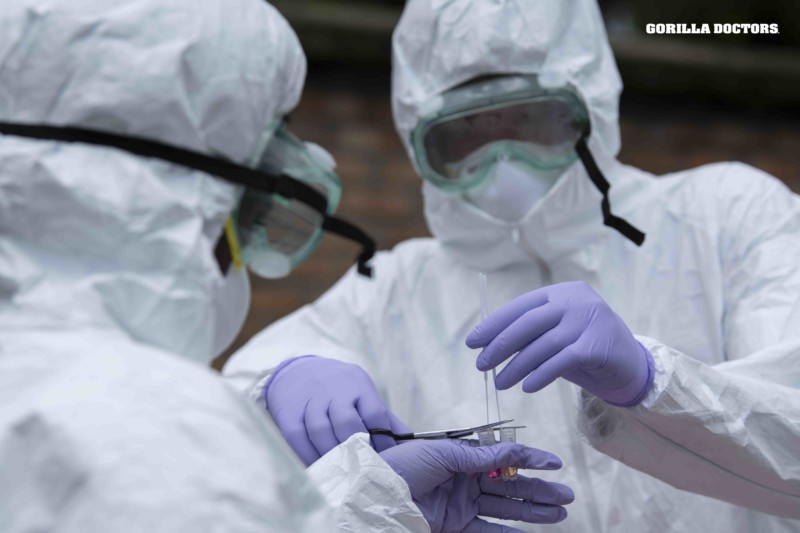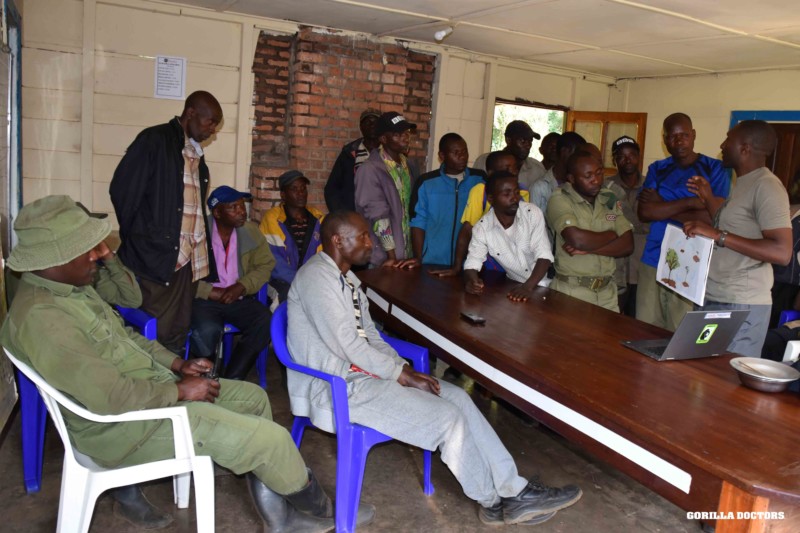Did you Know (Part 3 of 4): At the Forefront of Emerging Infectious Disease Research
By Gorilla Doctors Staff on Wednesday, April 29th, 2020 in Blog.In Part 1 of our ‘Did you Know’ series, we introduced the One Health scientific approach – recognizing that the health of people, animals and the environments we share are interconnected, and included some helpful definitions for understanding zoonotic disease (disease in humans caused by a pathogen that originated in animals). In Part 2, we gave you an in-depth look at our core mission – veterinary care to keep wild gorillas healthy. Today, with Part 3, we explore Gorilla Doctors’ work at the forefront of zoonotic disease research through its implementation of the USAID Emerging Pandemic Threats PREDICT project led by the One Health Institute for the past 10-years.
The Health of One Impacts the Health of All
Never before have we understood the concept of One Health more than we do today, as we face the COVID-19 pandemic as a global community. While we don’t yet have proof, it is likely that SARS CoV-2, the virus causing COVID-19 disease, emerged from an animal host and spilled over to infect humans. We are living a One Health moment – seeing what can happen when humans and animals interact in a shared environment in unsustainable ways with devastating consequences. A new study published by the UC Davis One Health Institute’s EpiCenter for Disease Dynamics found that habitat loss, human exploitation of wildlife and species extinction are directly connected to the increased risk of disease emergence, and that emergence is occurring at a more rapid rate than ever before1.
The USAID Emerging Pandemic Threats PREDICT project was launched in 2009 to address the increasing threat of disease emergence from global hotspots – highly biodiverse regions where there is a significant risk of zoonotic spillover from wildlife. Equatorial Africa is one of these hotspots where human populations are dense and growing, there is significant species diversity and a high degree of human-animal interaction, all of which combine to increase the risk of viral spillover. The goal of this 10-year surveillance effort was to detect and identify viruses circulating in wildlife and to better understand the behavioral and ecological drivers of spillover, in order to reduce the impact of disease emergence.

Gorilla Doctors and team field sample wildlife in Uganda, 2018. Photo by Skyler Bishop © Gorilla Doctors
PREDICT: Rwanda – Uganda – eastern DR Congo
Gorilla Doctors’ expertise in One Health, veterinary care and scientific research on infectious disease in great apes provided the foundation for implementing PREDICT surveillance in Rwanda, Uganda and eastern DR Congo. The need for PREDICT surveillance in these countries was clear, as the region’s rich biodiversity combined with high human population density creates regular opportunities for human-wildlife interactions. It is especially unique for its mountain gorilla tourism, bringing thousands of people from local communities and around the world, in close contact with endangered gorillas every day. Mountain gorillas and humans share 98.5% of their DNA and Gorilla Doctors’ research has shown ‘reverse’ zoonotic spillover – human pathogens can infect gorillas, causing respiratory disease2.
For the duration of PREDICT (2009-2019), Gorilla Doctor’s Head Veterinarians, Drs. Julius Nziza (Rwanda), Eddy Kambale Syaluha (DRC) and Benard Ssebide (Uganda), along with staff veterinarians and in collaboration with multiple partners, conducted field and laboratory surveillance for viruses in wild primates, bats, and rodents, and people where there was a high degree of human-wildlife contact (i.e. high risk for potential spillover). Over the last 10-years, Gorilla Doctors detected more than 55 novel viruses and more than 33 known viruses across the three countries. While none of these viruses were the SARS CoV-2 virus causing the COVID-19 pandemic, every discovery increases our overall global understanding of viral ecology and diversity in wildlife populations. Our PREDICT work also helped strengthen the regional One Health workforce, and increased understanding for local communities on the importance of living safely with wildlife.
Ebola Virus Outbreak – eastern DR Congo
When the Ebolavirus disease (EVD) outbreak began in eastern DR Congo in August 2018 (now the second largest in history), our DRC team worked closely with Congolese wildlife authorities to train park workers and their families and establish safety protocols to prevent the transmission of Ebolavirus to great apes in the region, including gorillas. Gorilla Doctors’ PREDICT work prior to the outbreak had a significant impact on building local community trust and understanding of zoonotic disease risk, including shifting behavior to reduce risk, living safely with wildlife and improving health outcomes when the outbreak began.
To date, there has been no detection of Ebolavirus in gorillas or EVD-related gorilla deaths in the Virungas or the Bwindi Impenetrable Forest. Gorilla Doctors and park authorities in all three countries have engaged in contingency planning with partners, should there be a positive Ebolavirus test in a gorilla and are prepared to act swiftly and safely to mitigate the spread.

Dr. Eddy conducts a workshop showing people in DRC ways to live safely with wildlife. © Gorilla Doctors
COVID-19 Pandemic
Since the World Health Organization declared COVID-19 a pandemic on March 11, 2020, we have reported on our veterinary work, considered an essential service in Rwanda, Uganda and DR Congo. Working closely with each government we are leading best practice safety measures to protect both people and gorillas and are prepared to treat gorillas should SARS CoV-2 spillover from humans to gorillas and cause disease. You can read about our efforts in any of these recent posts:
Did you Know (Part 2 of 4): Keeping Gorillas Healthy Everyday
Did you Know (Part 1 of 4): Gorilla Doctors + COVID-19
A Letter from our Executive Director: COVID-19
While we wish it had never been needed, Gorilla Doctors has been preparing for this global moment for more than a decade through our work at the nexus of wildlife medicine and emerging infectious disease. Our One Health approach brings this work full circle by addressing human health, our direct impact on gorilla health and the need to protect our shared ecosystem for the benefit of all. In Part 4 we place our work within the context of global conservation efforts and how, our choices, no matter how far removed they seem from the health of wild gorillas, has both direct and indirect consequences.
Want to be the first to receive Part 4? Subscribe for Updates and have our newest posts sent right to your inbox.
Follow us on Facebook, Instagram and Twitter.
References
1Johnson, et al. (2020). Proceedings of the Royal Society B 287: 20192736
2Palacios et al. (2011). Emerging Infectious Diseases 17: 711-713


 Donate
Donate

